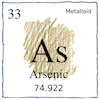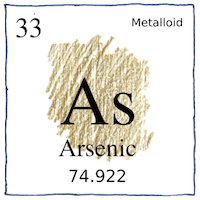Near East
elements

|
Arsenic
The alchemist Zosimos of Panopolis received a vision of arsenic from the fallen angels. Albertus Magnus synthesized philosophical and alchemical knowledge. Doesn’t Albert’s work suggest alchemical gold was only orpiment, an arsenic sulfide?
Atomic number 33
From the Persian for color of gold, commonly found in copper ore arsenic added strength to bronze, a heavy metal, steel gray, brittle, and toxic, realgar and orpiment (its sulfides), described by Dioscorides, the gift of the Borgias, king of poisons and poisoner of kings, powder of inheritance, Paris Green pigments as rodenticide and insecticide, Scheele’s green wallpaper that killed orphans, London Purple, Victorian fly papers, poison for spurned lovers readily available, arsenic cosmetics for that pale hue on the skin, Bradford sweets from Humbug Billy killed innocents who ate them, Paul Ehrlich’s Salvarsan a cure for syphilis, old lace and arsenic in elderberry wine a cure for lonely old men, common in groundwater, wood preservative, a feed additive for poultry and swine, and said to enhance the taste of wine.
Poison
They say that what doesn’t kill you only makes you stronger, but they’re full of it. The well-attested arsenic-eaters of Styria show us that poisons can offer a sufficient challenge. Listening to quacks and fakers long enough can put a hue on the cheek and a luster in the eye.



Albertus was a great philosopher, esteemed by the church; it wasn’t until Robert Boyle in 1661 that chemistry was separated from alchemy.
See also in The book of science:
Readings in wikipedia:
Other readings: